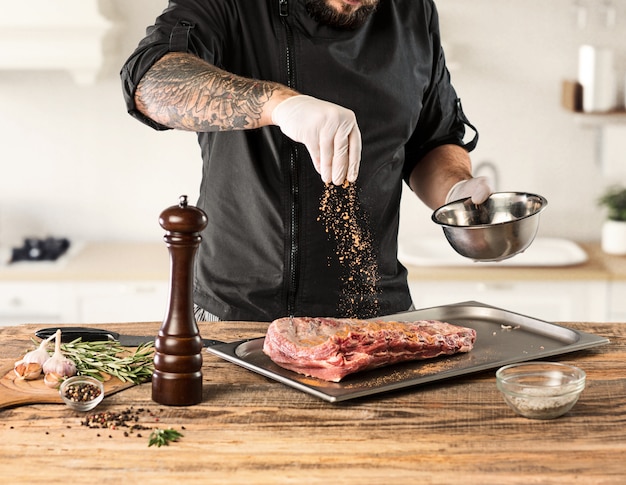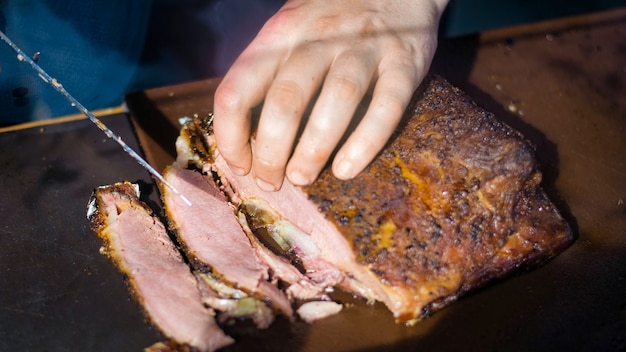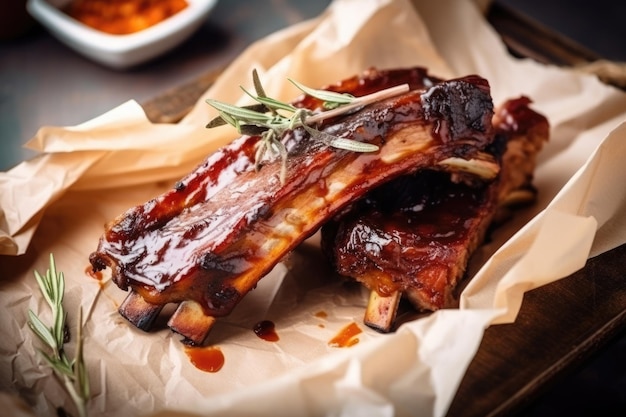Ah, the standing rib roast. Just the name conjures up images of a grand feast, a table overflowing with delicious food, and the warm glow of contented smiles. It's a dish that holds a special place in our hearts, a culinary masterpiece that elevates any gathering. But let's be honest, mastering the perfect rib roast can feel a bit like a daunting challenge. You've got that big hunk of meat, a fancy thermometer, and you're trying to avoid a dry, tough roast. Fear not, my friends, because this is your guide to nailing a standing rib roast that’ll have everyone licking their plates clean and begging for seconds.
Part 1: Choosing Your Rib Roast: The Foundation of Flavor

The first step in crafting a phenomenal rib roast is selecting the right cut. We're not just talking about any old bit of meat – we're aiming for quality. Look for a prime cut, preferably a standing rib roast with the bone still in. Why the bone, you ask? It helps to hold in moisture and adds a fantastic flavour to the meat, creating a truly unforgettable dining experience.
Prime Cuts and Beyond: Understanding the Grades
Now, when it comes to choosing the right cut, it’s all about the marbling. Those little streaks of fat running through the meat are what make the rib roast so juicy and tender. A good prime cut will have a decent amount of marbling, and that’s what you’re after. It's like the secret ingredient, adding depth and richness to every bite. The more marbling, the more flavour and tenderness you'll enjoy.
If you can find it, look out for "prime rib." It's basically a fancy name for a standing rib roast that’s a bit more decadent. It’s generally a bit more expensive, but it’s worth it for a special occasion. Imagine the look on your guests' faces as they savor every juicy morsel.
Size Matters: Feeding the Crowd
Don’t worry about getting the size exactly right; we’re talking about a roast here, not a delicate souffle. Go for a rib roast that will feed your guests comfortably. A 3-4 bone roast is good for about 6-8 people. If you're feeding a crowd, go bigger! Think about the occasion and how much you want to have left over for delicious sandwiches or a hearty hash.
Get to Know Your Butcher: Your Trusted Guide
Don’t be shy about asking your butcher for advice. They’re the experts, after all, and they can guide you to the best cut for your needs and budget. They can even tell you how long it’s going to take to cook, giving you a head start on planning your meal. Don't underestimate the value of a good butcher. They're a treasure trove of knowledge and culinary wisdom.
Part 2: Prepping Your Rib Roast: Setting the Stage for Success

So, you've got your beautiful rib roast, and you're ready to get cooking. But before you start the cooking process, there are a few things you need to do to ensure a perfect result. It’s all about prep, my friends. A little bit of effort now will pay off big time in the end.
Letting It Rest: Temperatures and Timing
The most important thing is to let your roast rest. That means taking it out of the fridge and letting it come to room temperature for at least an hour. This helps ensure even cooking and prevents a cold spot in the centre. Imagine the roast as a guest who needs a moment to acclimate to the new environment before making its grand entrance.
Seasoning is King: A Symphony of Flavors
Now, for the seasoning. This is where you can get creative. I'm a big fan of a simple salt and pepper rub. It’s like a blank canvas, allowing the natural flavors of the meat to shine. But if you’re feeling adventurous, try adding garlic powder, onion powder, paprika, or even a bit of chili powder. Think about the flavours you want to bring out and create a seasoning blend that complements your culinary vision.
The Fat Layer: A Secret Weapon
Don't forget to deal with that layer of fat on top. You can trim some of it off, but leave a decent layer. That fat is going to render down and keep the meat moist, resulting in a succulent and tender roast. Think of it as the meat's natural moisturizer, keeping it plump and delicious.
Roasting Rack: Elevating the Roast
This is a must-have. Use a roasting rack to lift your rib roast above the bottom of your roasting pan. This will allow for better air circulation and even cooking. Plus, it lets those delicious juices collect in the pan, which you can use later to create a rich and flavorful gravy. It's like a little stage for your culinary masterpiece.
Part 3: The Cooking Process: Unveiling the Magic

Right, now we’re getting into the heart of things. This is where you’re actually cooking your rib roast and creating that amazing, juicy result. Let’s talk about techniques and timing, the key elements in transforming a simple piece of meat into a culinary triumph.
High Heat Start: Searing the Flavor
You want to start your roast off with a high heat. Aim for around 450°F (232°C). This sears the outside and creates a nice crust, locking in the juices and enhancing the flavour. Think of it as a quick kiss of fire, adding a touch of smoky magic.
The First Step: Setting the Stage
Roast your rib roast for about 15 minutes at that high heat. This gets those juices flowing, preparing the meat for a slower, more gentle cooking process. It's like a warm-up act, getting everything ready for the main event.
Turn Down the Heat: A Gentle Embrace
After those initial 15 minutes, reduce the oven temperature to 325°F (163°C). This is the temperature you’ll need to cook your roast for the rest of the time. Imagine it as a gentle embrace, allowing the meat to slowly cook to perfection.
Don’t Open the Oven!: Resist the Temptation
This is a big one! The temptation to open the oven and peek at your roast is strong. But don't do it! Every time you open that oven door, you lose heat and the roast won't cook evenly. Think of it as a secret recipe that needs to unfold undisturbed.
Time and Temperature: The Perfect Balance
The cooking time depends on the size of your roast. A general rule of thumb is about 15 minutes per pound for medium-rare, 20 minutes per pound for medium, and 25 minutes per pound for well-done. But you need to use a meat thermometer! Don’t trust just time alone. This is where the thermometer becomes your most trusted ally, ensuring your roast is cooked to perfection.
Rest Time: Letting the Juices Redistribute
Once your rib roast is cooked to your desired temperature, take it out of the oven and let it rest for at least 15 minutes, covered with foil. This is crucial to allowing the juices to redistribute, making the meat even more tender and flavorful. Think of it as a final act of culinary grace, allowing the flavours to deepen and harmonize.
Part 4: Cooking Temperatures and Techniques: Mastering the Craft
It’s all well and good talking about “medium-rare” and “well-done,” but how do you actually know when your roast is done? And how do you cook it to your preferred level of doneness? The art of roasting involves a perfect blend of heat, time, and precision, ensuring every bite is a culinary delight.
The Magic of a Thermometer: Your Culinary Compass
It’s all about the meat thermometer. Don’t rely on the old “poke and see” method; get a good instant-read thermometer. They're cheap and they’re so much more accurate! It's like a culinary compass, guiding you towards a perfect outcome.
Doneness Guide: A Temperature Chart for Success
Here’s a simple guide to the internal temperatures for different levels of doneness. Remember, these are just guidelines. Experiment and find what you like best.
| Doneness | Internal Temperature (°F) |
|---|---|
| Rare | 125-130°F |
| Medium-Rare | 130-135°F |
| Medium | 135-140°F |
| Medium-Well | 140-145°F |
| Well-Done | 145-150°F |
The Temperature Trick: A Touch of Culinary Magic
Here's a little trick I’ve learned. Take your roast out of the oven 5-10 degrees before it reaches the desired internal temperature. It’ll continue to cook while it’s resting. This is a small but crucial detail, ensuring that your roast reaches the perfect level of doneness without overcooking.
Different Cooking Methods: Expanding Your Culinary Horizons
If you’re feeling a little adventurous, you can try other cooking methods that bring unique flavors and textures to your rib roast.
- reverse searing: This involves cooking the roast at a low temperature for a long time, followed by a quick sear at high heat. This results in a super-tender roast with a crispy crust. Imagine the contrast of a juicy, tender interior with a satisfyingly crisp exterior.
- Sous Vide: This involves sealing the roast in a vacuum bag and cooking it in a water bath. It’s all about precision cooking and results in incredibly even doneness. It's like a spa treatment for your meat, resulting in a flawlessly cooked masterpiece.
Part 5: Serving Your Masterpiece: A Culinary Celebration
You've cooked your rib roast to perfection, and now it's time to showcase your culinary masterpiece. The key is to let the meat rest and shine, allowing the flavours to truly develop and create a symphony of taste sensations.
Carving the Roast: An Artful Presentation
Don’t rush this part. A properly carved roast looks amazing and makes serving easier. If you’re struggling to carve, don’t be ashamed to ask your butcher for advice or to have them do it for you. They're experts, and they'll be happy to help. Remember, a beautifully carved roast adds an extra touch of elegance to your meal.
- Use a sharp carving knife. A sharp knife makes all the difference, ensuring clean cuts and a smooth, professional look.
- Start by cutting between the bones. This creates neat portions that are easy to serve.
- Slice across the grain of the meat for tender pieces. Cutting across the grain makes the meat more tender and easier to chew.
- Arrange the slices attractively on a platter. Presentation is key! A beautifully arranged platter adds an extra touch of elegance.
The Perfect Accompaniments: A Symphony of Flavors
Now, it’s time to choose the perfect sides for your roast. Think about the flavours you want to complement the rich, savoury taste of the meat. Each side should be like a harmonious note in your culinary symphony.
- Roasted Vegetables: Root vegetables like carrots, potatoes, and parsnips are a classic choice, or you can get more adventurous with Brussels sprouts or asparagus. The earthy sweetness of root vegetables complements the savoury flavour of the roast.
- Yorkshire Pudding: This light and fluffy pudding is the perfect way to soak up the rich gravy. It’s like a fluffy cloud that captures every drop of deliciousness.
- Gravy: Don’t forget the gravy! You can make it from the pan drippings, or you can use a store-bought gravy. A good gravy is the final touch, adding moisture and richness to the roast and its accompaniments.
Part 6: The Pan Drippings: Don’t Waste Them! A Treasure Trove of Flavor
You've got a beautiful roast and delicious sides, but you're not finished yet! Those pan drippings are full of flavor and should not be wasted! They’re the secret ingredient to an incredible gravy. Don’t let this culinary treasure go to waste.
Making the Best Gravy: Transforming Leftovers into Magic
- Skim the fat: Pour the pan drippings into a saucepan and let them cool slightly. Skim off any excess fat, but leave some in. The fat will add depth and richness to your gravy.
- Deglaze the pan: Add a little bit of wine or broth to the roasting pan, scraping up any browned bits. Pour this into the saucepan with the drippings. This technique extracts all the flavour from the pan, ensuring every last bit of goodness is incorporated into your gravy.
- Thicken it up: Stir in a cornstarch slurry (equal parts cornstarch and cold water) or a few tablespoons of flour to thicken the gravy.
- Season to taste: Add salt and pepper, and maybe a dash of herbs, to your gravy. A little bit of seasoning goes a long way, bringing your gravy to life.
- Serve it up! Pour your delicious gravy over your roast and sides. This final touch elevates your meal to a whole new level of deliciousness.
Part 7: Storing and Reheating Leftovers: Keeping the Flavors Alive
It’s a rare occurrence, but let’s be honest: you might have some leftover rib roast. Don't worry, you can still enjoy it in delicious ways. Proper storage and reheating ensure that your leftovers are as enjoyable as the original meal.
Storing Leftovers: Preserving the Flavors
- Chill It Down: Once the roast has cooled down, store it in an airtight container in the refrigerator. Refrigeration slows down bacterial growth, keeping your leftovers safe and delicious.
- Don’t Let It Sit Out: Never leave leftover cooked meat out at room temperature for more than two hours. It’s a breeding ground for bacteria. Always refrigerate leftovers promptly to ensure food safety.
Reheating Leftovers: Bringing Back the Magic
- Oven Reheating: This is a good option for reheating larger pieces of roast. Preheat your oven to 325°F (163°C). Place the roast in a baking dish and cover it with foil. Heat until warmed through, about 15-20 minutes. The oven provides even heating, ensuring your leftover roast stays moist and flavorful.
- slow cooker: If you’ve got a slow cooker, it’s a good way to keep leftover roast moist and flavorful. Place the roast in the slow cooker and add a little bit of broth or gravy. Cook on low for 2-3 hours, or until warmed through. The slow cooker is like a warm hug for your leftovers, keeping them tender and delicious.
Part 8: Creative Ways to Use Leftover Rib Roast: Turning Leftovers into Culinary Delights
Leftovers don’t have to be boring! There are so many creative ways to use that leftover rib roast, from sandwiches to pasta dishes. Get creative and let your culinary imagination soar!
- roast beef sandwiches: Slice the leftover rib roast and layer it on toasted bread with your favorite toppings, like cheese, horseradish, and a dollop of mustard. It's the perfect solution for a quick and satisfying lunch or dinner.
- Roast Beef Hash: Dice the leftover rib roast and sauté it with onions, peppers, and potatoes. It’s a hearty and flavorful dish that's perfect for a cold winter night.
- Roast Beef Soup: Make a hearty soup by simmering the leftover rib roast with vegetables and broth. It’s a comforting and satisfying meal that warms the soul.
- Roast Beef Tacos: Shred the leftover rib roast and use it as a filling for tacos. A fun and flavorful twist on traditional tacos.
FAQs: Answers to Your Burning Questions
1. Can I cook a rib roast in a slow cooker?
It's not ideal to cook a rib roast in a slow cooker. You might end up with a tough, dry roast. Slow cookers are best for more tender cuts of meat like chuck roast or brisket.
2. What if my rib roast isn’t perfectly seared?
Don't worry! A good sear is nice, but it's not the end of the world if it's not perfect. The most important thing is to cook your roast to the right internal temperature.
3. Can I freeze leftover rib roast?
Yes! Freeze the leftovers in an airtight container for up to 3 months. To thaw, move it from the freezer to the refrigerator the day before you plan to use it.
4. How do I tell if my rib roast is cooked to the right temperature?
Always use a meat thermometer to check the internal temperature of the roast. Don't rely on just looking at the color or poking it with a knife.
5. What if my rib roast is dry?
If you’ve cooked your rib roast to well-done and it’s a bit dry, don’t fret. You can make it more moist by adding a little bit of broth or gravy. Or, consider slicing it thinly and serving it on a bed of mashed potatoes.
Everyone is watching

Perfect Rice Every Time: The Ultimate Guide to Cooking Rice
Cooking TipsAs a self-proclaimed foodie, I've always been a bit obsessed with rice. It's the foundation of countless cuisi...

Prime Rib Roast Cooking Time Chart: Per Pound Guide
Cooking TipsPrime rib roast. Just the name conjures images of lavish dinners, crackling fires, and hearty laughter. It’s ...

The Ultimate Guide to Cooking Asparagus: Tips, Techniques, and Recipes
Cooking TipsAsparagus. The mere mention of this spring delicacy conjures up images of vibrant green spears, crisp and burs...

Ultimate Guide to Cooking the Perfect Thanksgiving Turkey
Cooking TipsThanksgiving. Just the word conjures up images of overflowing tables laden with delicious food, the scent of r...

How Long to Bake Potatoes in the Oven (Perfect Every Time)
Cooking TipsBaked potatoes are a staple in my kitchen. They're incredibly versatile, delicious, and surprisingly easy to m...
